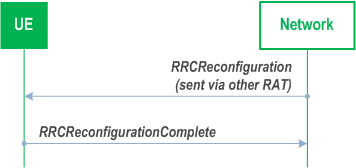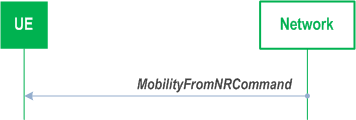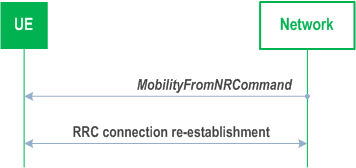Content for TS 38.331 Word version: 18.0.0
1…
4…
5…
5.2.2.4…
5.3…
5.3.3…
5.3.5…
5.3.5.5…
5.3.5.6…
5.3.5.7…
5.3.5.13…
5.3.5.17…
5.3.6…
5.3.8…
5.3.13…
5.3.14…
5.4…
5.5…
5.5.3…
5.5.4…
5.5.4.15…
5.5.4.23…
5.5.5…
5.5a…
5.7…
5.7.4…
5.7.8…
5.7.12…
5.8…
5.8.9…
5.8.9.2…
5.8.9.8…
5.8.10…
5.8.11…
5.9…
5.10…
6…
6.2.2…
6-2-2-23…
6-2-2-27…
6-2-2-43…
6-2-2-47…
6.3…
6.3.2…
6-3-2-27…
6-3-2-49…
6-3-2-73…
6-3-2-95…
6-3-2-108…
6-3-2-134…
6-3-2-162…
6-3-2-188…
6-3-2-213…
6-3-2-243…
6-3-2-271…
6-3-2-297…
6-3-2-341…
6.3.3…
6-3-3-25…
6-3-3-51…
6.3.4…
6.3.5…
6-3-5-25…
6.3.6…
6.4…
7…
9…
11…
A…
A.4…
B…
5.4 Inter-RAT mobility
5.4.1 Introduction
5.4.2 Handover to NR
5.4.2.1 General
5.4.2.2 Initiation
5.4.2.3 Reception of the RRCReconfiguration by the UE
5.4.3 Mobility from NR
5.4.3.1 General
5.4.3.2 Initiation
5.4.3.3 Reception of the MobilityFromNRCommand by the UE
5.4.3.4 Successful completion of the mobility from NR
5.4.3.5 Mobility from NR failure
...
...
5.4 Inter-RAT mobility p. 210
5.4.1 Introduction p. 210
Network controlled inter-RAT mobility between NR and E-UTRA, where E-UTRA can be connected to either EPC or 5GC, and from NR to UTRA-FDD is supported.
5.4.2 Handover to NR p. 210
5.4.2.1 General p. 210

The purpose of this procedure is to, under the control of the network, transfer a connection between the UE and another Radio Access Network (e.g. E-UTRAN) to NR.
The handover to NR procedure applies when SRBs, possibly in combination with DRBs, are established in another RAT. Handover from E-UTRA to NR applies only after integrity has been activated in E-UTRA.
5.4.2.2 Initiation p. 211
The RAN using another RAT initiates the handover to NR procedure, in accordance with the specifications applicable for the other RAT, by sending the RRCReconfiguration message via the radio access technology from which the inter-RAT handover is performed.
The network applies the procedure as follows:
- to activate ciphering, possibly using NULL algorithm, if not yet activated in the other RAT;
- to re-establish SRBs and one or more DRBs;
5.4.2.3 Reception of the RRCReconfiguration by the UE p. 211
The UE shall:
1 >
apply the default L1 parameter values as specified in corresponding physical layer specifications except for the parameters for which values are provided in SIB1;
1 >
apply the default MAC Cell Group configuration as specified in clause 9.2.2;
1 >
perform RRC reconfiguration procedure as specified in clause 5.3.5;
5.4.3 Mobility from NR p. 211
5.4.3.1 General p. 211


The purpose of this procedure is to move a UE in RRC_CONNECTED to a cell using other RAT, e.g. E-UTRA, UTRA-FDD. The mobility from NR procedure covers the following type of mobility:
- handover, i.e. the MobilityFromNRCommand message includes radio resources that have been allocated for the UE in the target cell;
5.4.3.2 Initiation p. 212
The network initiates the mobility from NR procedure to a UE in RRC_CONNECTED, possibly in response to a MeasurementReport or an MCGFailureInformation message, by sending a MobilityFromNRCommand message. The network applies the procedure as follows:
- the procedure is initiated only when AS security has been activated, and SRB2 with at least one DRB or multicast MRB are setup and not suspended;
- the procedure is not initiated if any DAPS bearer is configured;
5.4.3.3 Reception of the MobilityFromNRCommand by the UE p. 212
The UE shall:
1 >
stop timer T310, if running;
1 >
stop timer T312, if running;
1 >
if T316 is running:
2 >
1 >
stop timer T316;
2 >
if the UE supports RLF-Report for fast MCG recovery procedure:
3 >
2 >
set the elapsedTimeT316 in the VarRLF-Report to the value of the elapsed time of the timer T316;
3 >
set the pSCellId to the global cell identity of the PSCell, if available, otherwise to the physical cell identity and carrier frequency of the PSCell;
else:
3 >
clear the information included in VarRLF-Report, if any;
if T390 is running:
2 >
1 >
stop timer T390 for all access categories;
2 >
perform the actions as specified in clause 5.3.14.4;
inform upper layers about the release of all application layer measurement configurations;
1 >
discard any application layer measurement reports which were not yet submitted to lower layers for transmission;
1 >
if the targetRAT-Type is set to eutra:
2 >
1 >
consider inter-RAT mobility as initiated towards E-UTRA;
2 >
forward the nas-SecurityParamFromNR to the upper layers, if included;
else if the targetRAT-Type is set to utra-fdd:
2 >
1 >
consider inter-RAT mobility as initiated towards UTRA-FDD;
2 >
forward the nas-SecurityParamFromNR to the upper layers, if included;
if successHO-Config is configured:
2 >
1 >
consider itself to be configured to provide the successful handover information for inter-RAT handover in accordance with clause 5.7.10.6;
else:
2 >
1 >
consider itself not to be configured to provide the successful handover information for inter-RAT handover.
access the target cell indicated in the inter-RAT message in accordance with the specifications of the target RAT.
5.4.3.4 Successful completion of the mobility from NR p. 213
Upon successfully completing the handover, at the source side the UE shall:
1 >
reset MAC;
1 >
stop all timers that are running except T325, T330 and T400;
1 >
release ran-NotificationAreaInfo, if stored;
1 >
release the AS security context including the KRRCenc key, the KRRCint key, the KUPint key and the KUPenc key, if stored;
1 >
release all radio resources, including release of the RLC entity and the MAC configuration;
1 >
release the associated PDCP entity and SDAP entity for all established RBs;
1 >
if the UE was configured with successHO-Config when connected to the source PCell and the targetRAT-Type is set to eutra:
2 >
1 >
perform the actions for the successful handover report determination as specified in clause 5.7.10.6.
if the targetRAT-Type is set to eutra and the nas-SecurityParamFromNR is included: or
1 >
if the targetRAT-Type is set to utra-fdd:
2 >
indicate the release of the RRC connection to upper layers together with the release cause 'other'.
5.4.3.5 Mobility from NR failure p. 213
The UE shall:
1 >
if the UE does not succeed in establishing the connection to the target radio access technology:
2 >
1 >
if the targetRAT-Type in the received MobilityFromNRCommand is set to eutra and the UE supports Radio Link Failure Report for Inter-RAT MRO EUTRA:
3 >
2 >
store handover failure information in VarRLF-Report according to clause 5.3.10.5;
if voiceFallbackIndication is included in the MobilityFromNRCommand message; or
2 >
if the mobility from NR procedure is for emergency services fallback as specified in TS 23.502:
3 >
2 >
attempt to select an E-UTRA cell:
4 >
if a suitable E-UTRA cell is selected; or
4 >
if no suitable E-UTRA cell is available and an acceptable E-UTRA cell supporting emergency call is selected when the UE has an ongoing emergency call:
5 >
4 >
perform the actions upon going to RRC_IDLE as specified in clause 5.3.11, with release cause 'RRC connection failure';
else:
5 >
revert back to the configuration used in the source PCell;
5 >
initiate the connection re-establishment procedure as specified in clause 5.3.7;
else:
3 >
revert back to the configuration used in the source PCell;
3 >
initiate the connection re-establishment procedure as specified in clause 5.3.7;
else if the UE is unable to comply with any part of the configuration included in the MobilityFromNRCommand message; or
1 >
if there is a protocol error in the inter RAT information included in the MobilityFromNRCommand message, causing the UE to fail the procedure according to the specifications applicable for the target RAT:
2 >
if the targetRAT-Type in the received MobilityFromNRCommand is set to eutra and the UE supports Radio Link Failure Report for Inter-RAT MRO EUTRA:
3 >
2 >
store handover failure information in VarRLF-Report according to clause 5.3.10.5;
revert back to the configuration used in the source PCell;
2 >
initiate the connection re-establishment procedure as specified in clause 5.3.7.